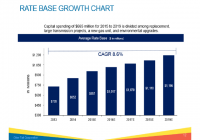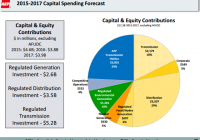Dominion Resources: A Little Patience May Go A Long Way
Summary Dominion Resources has been discussed for its strong fundamentals and various initiatives underway to drive future growth. The data supports that view: book value, earnings, cash and revenue have all grown slowly but steadily in the past and likely will continue growth going forward. However, shares are currently at a premium; investors might be well-advised to wait for a more favorable entry point. There were opportunities before – there likely will be again. Introduction An insightful contributor to SA recently wrote about the strong business fundamentals and growth prospects of Dominion Resources, Inc. (NYSE: D ). The author did a thorough job describing the various initiatives which may drive growth in the future and offered the opinion that the current premium pricing is justified. While the growth initiatives have been well documented, it seems appropriate to more fully explore the current price-to-value relationship of this company. At the current price of about $70, are shares fairly valued? If not, are they priced at a premium right now, or a discount? This article seeks to contribute to the Dominion conversation by exploring a valuation methodology for consideration. The analysis is presented in two-steps: 1) A review of company fundamental metric performance, and 2) a PE valuation calculation. The idea is to assess a company’s historical performance as a guideline for possible future results. The assumption is that solid fundamentals lend themselves to relative predictability over longer periods of time. Then, for high-quality companies with strong track records, over time pricing matches valuation. So the question at hand is to assess the pricing-to-valuation situation right now for Dominion. Step 1: Dominion Resources, Inc. – Historical Trends in Fundamental Metrics In order to assess fundamental performance, it is reasonable to review trends in book value per share, earnings per share, cash flow per share and revenue per share. Book Value Per Share Like always, F.A.S.T. Graphs provides a useful visual. As shown on the graphic below, D has delivered slow and steady balance sheet growth over the period studied. (click to enlarge) source: www.fastgraphs.com Earnings Per Share In my opinion, D has delivered fairly modest earnings per share growth over time. Single-digit growth, while growth, is nothing extraordinary. The graph below indicates this trend is solid, but certainly not spectacular. (click to enlarge) source: www.fastgraphs.com Cash Flow Per Share From my perspective, the data suggests that Dominion management has done an effective job managing cash successfully over long periods of time. Substantial capital investments have increased the earnings capabilities of the company as evidenced by the data. (click to enlarge) source: www.fastgraphs.com Revenue Per Share IMHO, the data again suggests modest revenue growth over periods of time. This seems to suggest a solid position in the market place, but nothing exceptionally over and above the peer group to suggest premium pricing. (click to enlarge) source: fastgraphs.com Based on a review of the data, in my opinion Dominion is a quality company with a track record of success and a variety of initiatives to grow earnings going forward. Results are not spectacular; modest would be a better description. The next step is to determine: at current price levels, are D shares fairly valued, at a premium, or a discount? Step 2: A Possible Valuation When valuing a company, I like to compare that company against its own historical valuation. As usual, F.A.S.T. Graphs comes in very handy. In the chart below, the orange line represents earnings history and what could be considered “fair valuation” at a price/earnings multiple of 15X. The blue line represents a historic normalized average P/E. Finally, the black line is the market price of D. Looking carefully at the graphic below, we can observe that the historical normal PE for D is 15.8X earnings. Today D is priced at 19.5X earnings or more. This is portrayed by the black price line currently above the blue and orange line. (click to enlarge) source: fastgraphs.com So it appears that shares are priced at a premium right now. Just how much of a premium? To purchase D today an investor would be paying nearly 20X earnings when the norm is for an investor to pay 15.8X earnings. And it is noticeable that PE multiples have been growing steadily for this company for that past 5+ years. We can also note there were times in 2011, 2012 and 2013 where this company was available for 15-17X earnings if a person was patient and willing to buy at price levels below the average PE. So what might be a reasonable target entry point? If we apply the average PE multiple to 2015 estimated EPS, an entry point around $58 seems to offer a margin of safety. This may be especially important in a skittish market overall. IMHO, even though the company has a number of initiatives underway, there is downside risk when paying at prices above historical valuation norms. Over time the price tends to revert to the average valuations. In this case, buying above the average may present downside risk. Conclusion This article was intended to add to the conversation by looking at trended financial fundamentals and a closer look at valuation. IMHO, Dominion is a quality company with initiatives and investments under way to generate future earnings growth. However, at current price levels shares are priced at a premium. Investors may be well-served to be patient and wait for pullbacks to at least normal PE levels, or perhaps consider selling puts as a way to enter a position at an even better entry point. As always, all of the above opinions offered for your consideration as you make your own investment decisions. Commentary is intended simply as a contribution to the discussion only. Thank you very much for reading. Disclosure: I/we have no positions in any stocks mentioned, and no plans to initiate any positions within the next 72 hours. (More…) I wrote this article myself, and it expresses my own opinions. I am not receiving compensation for it (other than from Seeking Alpha). I have no business relationship with any company whose stock is mentioned in this article.

